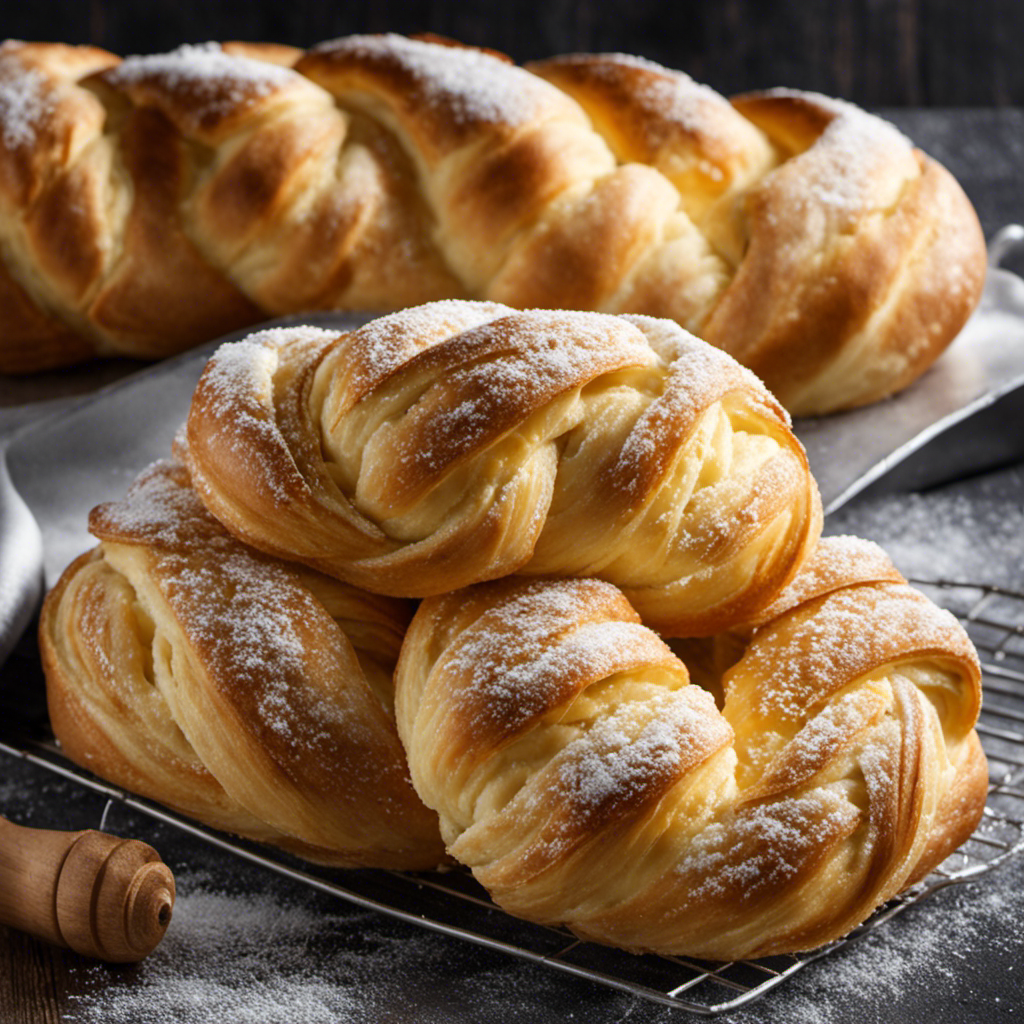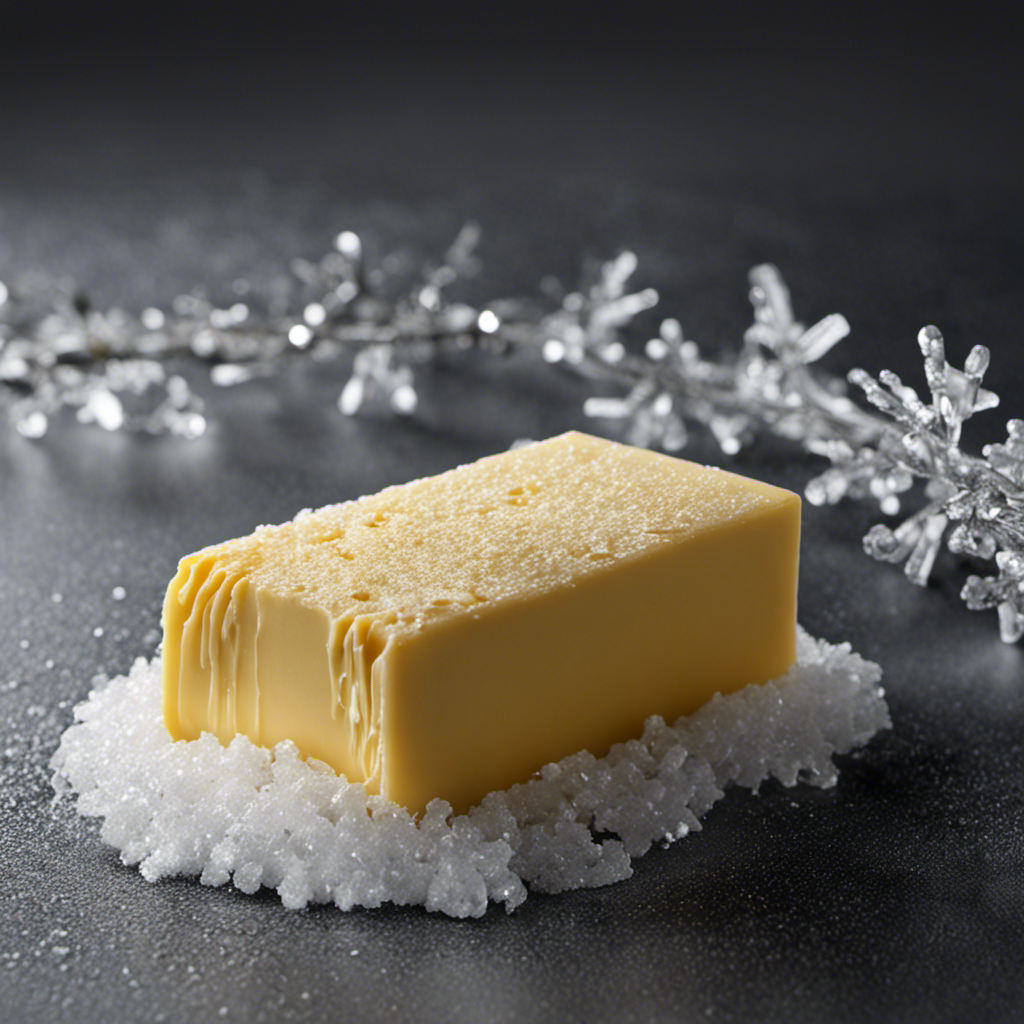As a food lover, I’ve always been curious about the shelf life of my beloved butter chicken in the refrigerator. Therefore, I ventured into the realm of food storage recommendations to seek some clarity.
In this article, I’ll share evidence-based information on the recommended storage temperature, shelf life, and factors affecting the longevity of butter chicken in the fridge.
Additionally, I’ll provide tips on properly storing leftovers, extending freshness, reheating safely, and freezing for long-term storage.
Let’s dive in and discover the secrets of keeping butter chicken fresh!
Key Takeaways
- Consume butter chicken within 3-4 days in the fridge
- Store butter chicken in airtight containers to prevent cross-contamination
- Use glass or plastic containers with tight-fitting lids to maintain freshness
- Reheat leftovers thoroughly to 165°F (74°C)
Storage Guidelines for Butter Chicken
If you’re wondering how long butter chicken lasts in the fridge, it’s typically recommended to consume it within 3-4 days. To ensure its safety and quality, it’s important to follow proper storage guidelines.
When reheating leftover butter chicken, it’s best to use the stove or microwave. Make sure to heat it thoroughly, reaching a minimum internal temperature of 165°F (74°C), to kill any potential bacteria.
If you’re looking for alternative uses for leftover butter chicken, consider transforming it into a delicious wrap or adding it to a salad for added flavor. The rich and flavorful sauce can also be used as a marinade for grilled meats or as a topping for roasted vegetables.
With a little creativity, you can repurpose your leftover butter chicken into new and exciting dishes.
Recommended Storage Temperature for Butter Chicken
The recommended temperature to store butter chicken is in the fridge. Storing butter chicken at proper temperatures is crucial to ensure its freshness and prevent the growth of harmful bacteria.
The ideal temperature for refrigerated storage is below 40°F (4°C). This helps to slow down bacterial growth and maintain the quality of the dish for a longer period.
It is important to store butter chicken in airtight containers to prevent cross-contamination and maintain its flavor and texture. Glass or plastic containers with tight-fitting lids are the best options for storing butter chicken in the fridge.
These containers help to keep the dish fresh and protect it from absorbing odors from other foods in the refrigerator.
Shelf Life of Butter Chicken in the Fridge
The shelf life of butter chicken in the fridge can vary depending on the storage conditions and freshness of the ingredients. Proper storage is essential to maintain its quality and ensure food safety.
According to storage guidelines, butter chicken can typically last for about 3 to 4 days in the refrigerator. It is important to store it in an airtight container to prevent moisture loss and contamination.
When reheating, make sure to heat it thoroughly to an internal temperature of 165°F (74°C) to kill any potential bacteria.
If you plan to keep it for longer, it is advisable to freeze the butter chicken. When frozen, it can last for up to 3 months. Remember to label the container with the date to keep track of its freshness.
Factors Affecting the Longevity of Butter Chicken
Factors like storage conditions, ingredient freshness, and proper reheating can affect how long butter chicken stays fresh in the fridge.
When it comes to storage conditions, keeping butter chicken at a constant temperature of 40°F or below is crucial. This prevents the growth of harmful bacteria that can spoil the dish.
Additionally, the freshness of ingredients can greatly impact the taste and longevity of the dish. Using fresh chicken and spices will enhance the flavor and extend the shelf life.
Proper reheating is also important to prevent spoilage. Make sure to heat the butter chicken to an internal temperature of 165°F to kill any bacteria that may have developed during storage.
Signs of Spoiled Butter Chicken
When it comes to determining if butter chicken has spoiled, there are several key indicators to look out for.
First and foremost, the smell test is crucial – if the dish emits a rancid or foul odor, it is likely no longer safe to consume.
Additionally, changes in texture are a telltale sign of spoilage, as the chicken may become slimy or mushy.
Lastly, keep an eye out for any noticeable color changes, such as a greenish tint or patches of mold, as these are clear indications that the butter chicken has gone bad.
Smell Test for Spoilage
One way to determine if butter chicken has gone bad is by giving it a smell test. The smell of spoiled butter chicken is usually unpleasant and sour. However, it is important to note that the reliability of the smell test can vary. To help you understand the reliability of the smell test, here is a table highlighting alternative ways to check for spoilage:
| Method | Reliability | Description |
|---|---|---|
| Visual Inspection | High | Look for mold, discoloration, or signs of decay |
| Texture Examination | Medium | Check for sliminess, mushiness, or unusual texture |
| Taste Test | Low | Taste a small amount to see if it tastes off |
| Expiration Date | High | Check the date on the packaging |
| Packaging Condition | Medium to High | Look for signs of leakage or damage |
As you can see, the smell test is just one of the ways to determine if butter chicken has spoiled. In the next section, we will explore how texture changes when spoiled.
Texture Changes When Spoiled
To determine if your butter chicken has spoiled, feel for any sliminess, mushiness, or unusual texture. Texture changes can be strong indicators of spoilage in food. When butter chicken spoils, it may develop a slimy or mushy texture, indicating the growth of bacteria or mold. The texture can become unpleasantly soft or even gritty. Spoiled butter chicken may also have a grainy or stringy texture, which is a result of the breakdown of proteins. These texture changes occur due to the degradation of the ingredients and the growth of microorganisms. If you notice any of these spoilage indicators, it is best to discard the butter chicken to avoid foodborne illnesses.
Now, let’s explore another important aspect of determining spoilage: color changes indicate spoilage.
Color Changes Indicate Spoilage
In the previous section, I discussed how changes in texture can indicate that butter chicken has spoiled. Another important factor to consider when determining the freshness of butter chicken is its color. Color changes in food can be a sign of microbial growth and potential food safety issues.
Here are some key points to keep in mind regarding color changes in butter chicken:
- Fresh butter chicken typically has a vibrant orange color.
- If the color of the butter chicken turns dull or grayish, it may indicate spoilage.
- Green or blue spots on the butter chicken can suggest the presence of mold.
- Any discoloration, such as black or brown patches, should be considered a warning sign.
It is crucial to pay attention to these color changes as they can help you determine whether the butter chicken is still safe to consume.
Now let’s move on to the next section where I will discuss the proper way to store leftover butter chicken.
Properly Storing Leftover Butter Chicken
If you want to properly store leftover butter chicken, make sure to seal it in an airtight container before placing it in the fridge. This is crucial in prolonging the freshness of the dish and preventing bacterial growth.
When exposed to air, butter chicken can quickly become a breeding ground for bacteria, which can lead to foodborne illnesses. By sealing it in an airtight container, you create a barrier that prevents air and moisture from reaching the chicken, reducing the risk of spoilage.
Additionally, it is important to place the container in the coldest part of the fridge, usually the back or bottom shelf, to maintain a consistently low temperature.
Tips to Extend the Freshness of Butter Chicken
Sealing leftover butter chicken in an airtight container helps preserve its freshness and prevents bacterial growth. To ensure the longevity of your butter chicken, here are some tips to follow:
- Store the leftovers in a clean and dry container.
- Use containers specifically designed for storing food, such as glass or BPA-free plastic containers.
- Make sure the container is airtight to prevent moisture and odors from seeping in.
- Place the container in the coldest part of the refrigerator, usually the back of the bottom shelf.
By following these steps, you can extend the freshness of your butter chicken and prevent the growth of harmful bacteria.
Now that you know how to store your leftovers properly, let’s move on to the next section and learn about reheating butter chicken safely.
Reheating Butter Chicken Safely
To safely reheat leftover butter chicken, you can use the stovetop or microwave. Both methods can effectively warm up your dish while maintaining its flavors and textures.
If using the stovetop, place the butter chicken in a pan over low heat. Stir occasionally to ensure even heating.
If using the microwave, transfer the butter chicken to a microwave-safe dish and cover with a microwave-safe lid or plastic wrap, leaving a small vent for steam to escape. Heat in short intervals, stirring in between, until the desired temperature is reached.
When reheating, it’s important to be mindful of the spices used in butter chicken. Some of the best spices for butter chicken include garam masala, turmeric, cumin, and coriander. These spices not only add a rich and aromatic flavor to the dish but also have health benefits.
Freezing Butter Chicken for Long-Term Storage
When frozen, butter chicken can be stored for an extended period of time. Freezing is a great way to preserve the flavors of butter chicken and ensure its freshness for future consumption.
To freeze butter chicken properly, follow these simple steps:
- Allow the dish to cool completely before freezing to prevent the formation of ice crystals.
- Divide the butter chicken into individual portions or use airtight containers to store larger quantities.
- Label each container with the date of freezing to keep track of its shelf life.
- Place the containers in the freezer and ensure they are well-sealed.
When it comes to thawing frozen butter chicken, it is best to transfer it to the refrigerator and allow it to thaw overnight. This gradual thawing process helps maintain the texture and taste of the dish. Avoid thawing at room temperature, as this can promote bacterial growth.
Frequently Asked Questions
Can I Leave Butter Chicken at Room Temperature for a Few Hours Before Refrigerating It?
Leaving butter chicken at room temperature is not safe as it can lead to bacterial growth. It is recommended to refrigerate it immediately after cooking to prevent foodborne illnesses.
Can I Store Butter Chicken in the Freezer for an Extended Period of Time?
Yes, you can freeze butter chicken for months. It is best to store it in glass containers to maintain its quality. Freezing helps preserve the dish and extends its shelf life.
Can I Reheat Butter Chicken Multiple Times?
Yes, you can reheat butter chicken multiple times. However, each time you reheat it, the flavor may diminish slightly. To preserve the flavor, try to reheat it gently and avoid overheating.
Can I Store Butter Chicken in a Plastic Container?
Using glass containers for food storage has several benefits, such as being non-toxic and reusable. If you’re looking for alternatives to plastic containers for storing butter chicken, consider using glass containers for a safer option.
Can I Freeze Butter Chicken in the Original Packaging It Came In?
Yes, you can freeze butter chicken in the original packaging it came in. However, it is recommended to transfer it to an airtight container or freezer bag to maintain the quality and prevent freezer burn.
Conclusion
In conclusion, it’s essential to properly store butter chicken to ensure freshness and avoid spoilage.
According to storage guidelines, butter chicken can last for up to 3-4 days in the fridge when stored at a temperature below 40°F (4°C).
However, a fascinating statistic reveals that by freezing butter chicken, its shelf life can be extended to 4-6 months. This allows you to enjoy this delectable dish even after an extended period.
Remember to follow the recommended storage and reheating methods for a safe and delicious experience.










